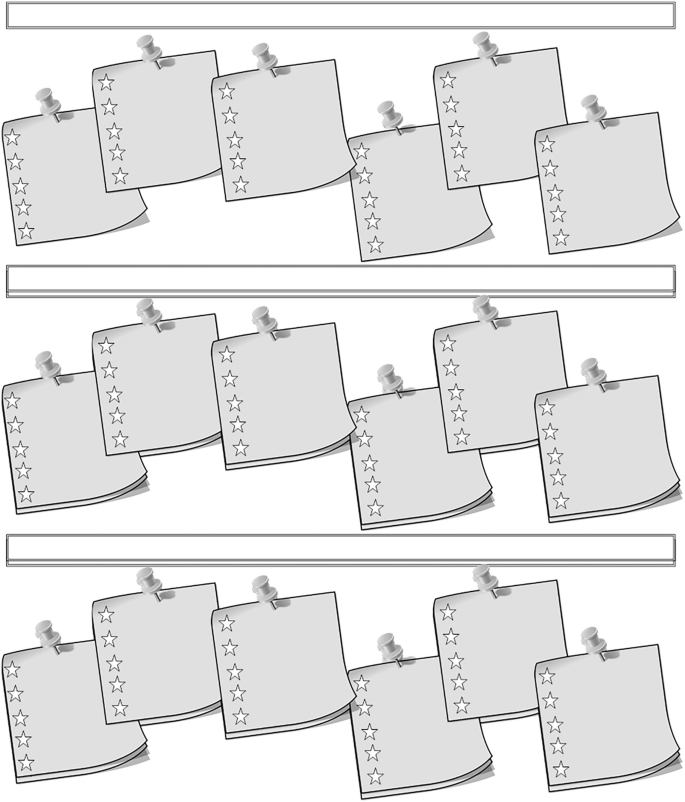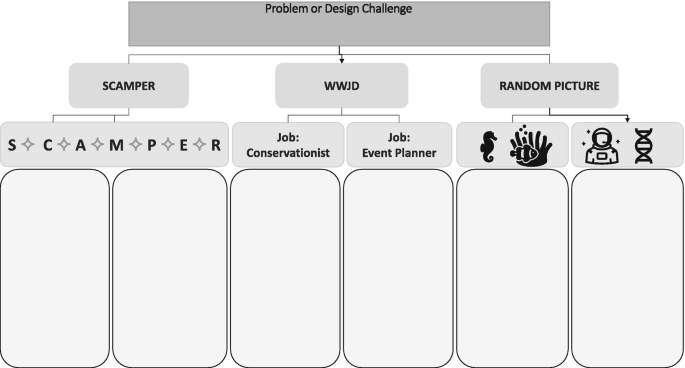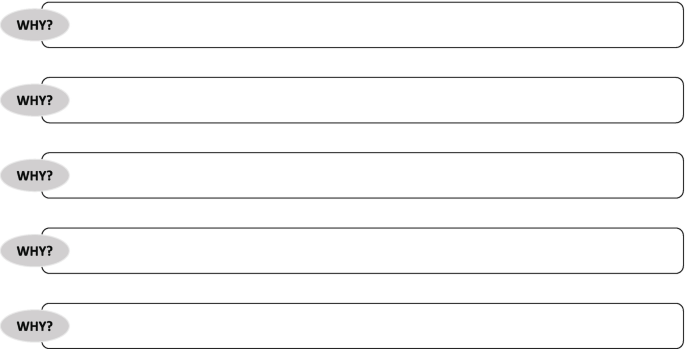Abstract
It is a myth that creative genii sit quietly hoping for inspiration and insight come to them in a flash of illumination. Some discoveries are either by accident or the result of some form of creative “spark of genius”, but for most novel, valuable business solutions, problem-solving often starts with a design challenge/problem or opportunity. Thanks to decades of research and tried-and-tested tools applied in a range of domains and business disciplines, a treasure trove of creative problem-solving tools and techniques is available to creatives and innovators. These tools turn problems into possibilities, and provide opportunities to develop ideas, processes, products, or procedures that are new to that job, team or organization. Business Schools and industries have no shortage of models, frameworks and tools to improve business effectiveness or generate new and interesting problem solutions for clients. Thinking tools have merit and include divergent or convergent (or both) thinking techniques. We cover thirteen of the most well-known and useful tools and techniques in this chapter. There are many more, but the scope of this book limits what can be covered here.
Access this chapter
Tax calculation will be finalised at checkout
Purchases are for personal use only
Similar content being viewed by others
Notes
- 1.
Read the book by Stokes, P.D. (2006). Creativity from Constraints about the various disciplines, from literature to fashion, advertising and architecture, to music. ISBN 0–8261–7845-6
References
Osborn AF. Applied imagination. New York: Charles Schribner’s Sons; 1953.
Janis IL. Groupthink. IEEE Eng Manag Rev. 2008;36(1):36.
Paulus PG, Dzindolet MT, Poletes G, Camacho LM. The illusion of group productivity. Personal Soc Psychol Bull. 1993;19:78–89.
Paulus PG, Dzindolet MT. Social influence processes in group brainstorming. J Pers Soc Psychol. 1993;64:575–86.
McLeod S. Solomon Asch – conformity experiment. SimplyPsychology.org: simply psychology; 2018.
Greenfield R. Brainstorming doesn’t work; try this technique instead. FastCompnay; 2014. Available from: https://www.fastcompany.com/3033567/brainstorming-doesnt-work-try-this-technique-instead
Rietzschel EF, Nijstad BA, Stroebe W. Productivity is not enough: a comparison of interactive and nominal brainstorming groups on idea generation and selection. J Exp Soc Psychol. 2006;42(2):244–51.
Thompson L. Creative conspiracy: the new rules of breakthrough collaboration. Harvard Business Review Press; 2013.
Right Source. 2017. Available from: https://www.rightsourcemarketing.com/content-creation/everything-know-brainstorming-wrong/
Griffiths C, Costi M. The creative thinking handbook: your step-by-step guide to problem solving in business. New York: Kogan Page Ltd; 2019.
Ayshford E. Why your next brainstorm should begin with an embarrassing story. Kellogg School of Management at Northwestern University; 2019. Available from: https://insight.kellogg.northwestern.edu/article/boost-creativity-brainstorm-embarrassment?utm_source=piano&utm_medium=onsite&utm_campaign=364L
Buzan T, Griffiths C. Mind maps for business: revolutionize your business thinking and practice. Harlow: BBC Active; 2010.
Eberle B. Scamper on: Games for imagination development. New York: D.O.K Publisher Inc; 1971.
De Bono E. Six thinking hats. London: Penguin; 2017.
De Bono E. Six thinking hats. New York: Little, Brown & Company; 1985.
Ohno T. Ask ‘why’ five times about every matter. 2006. Available from: https://www.toyota-myanmar.com/about-toyota/toyota-traditions/quality/ask-why-five-times-about-every-matter
Duncan K. The ideas book: 50 ways to general ideas visually. London: LID; 2014.
Gentner D, Bowdle B, Wolff P, Boronat C. Metaphor is like analogy. The analogical mind: perspectives from cognitive science. 2001. p. 99–253.
Gentner D. The mechanisms of analogical learning. In: Vosniadou S, Ortony A, editors. Similarity and analogical reasoning. Cambridge: Cambridge University Press; 1989. p. 199–241.
Gordon WJJ. Synetics: the development of creative capacity. New York: Harper & Row; 1961.
Det N. Synectics classroom demo by Dr. Chitra Sohani YouTube; 2019. https://www.youtube.com/watch?v=YwVelaJQCcs
Clapham MM. The development of innovative ideas through creativity training. In: Shavinina LV, editor. The international handbook on innovation. Oxford: Pergamon; 2003. p. 366–76.
Kostoff RN. Stimulating innovation. The international handbook on innovation. 2003. p. 388–400.
Dhanoa HK, Nanda S. Effect of synectics model on language creativity: a review. Int J Multidiscip Educ Res. 2019;8(1).
Prince G. The operational mechanism of synectics. J Creat Behav. 1968;2:1–13.
Nolan V. Whatever happened to Synectics? Creat Innov Manag. 2003;12(1):25.
Starko AJ. Creativity in the classroom: schools of curious delight. London: Routledge; 2010.
Sawyer RK. The science of human innovation: Explaining creativity. New York: Oxford University Press; 2012.
Author information
Authors and Affiliations
Corresponding author
Editor information
Editors and Affiliations
CREATiViTY LABORatory
CREATiViTY LABORatory
1.1 Activity I: Self-Directed Brainwriting
Brainstorming is a group or team activity and is unlikely to have the same useful outcome when done as an individual (right?  ) but a form of brainwriting, combined with incubation, might just deliver those treasured new ideas. Here is the way.
) but a form of brainwriting, combined with incubation, might just deliver those treasured new ideas. Here is the way.
-
1.
Write down a problem (or design challenge) as concisely and as accurate as possible in the first one of the framed boxes in Fig. 10.2. (If you cannot think of one, here is one for you to mentally chew on: Too few parents volunteer for parent-teacher events to help teachers raise funds for additional school resources.)
-
2.
At the top of each Post-it note, next to the pin, write down a category or discipline you think can think of that may have something/nothing to do with the problem. Suggested: Furniture, Toys, Utensils, Tools, Scientific Instruments, Transportation, Appliances, Weapons, Health/Medicine, Fashion & Personal Accessories). (2) Brainstorm ideas – in your own mind! Do not stop until you have 5 or 6 ideas under each Post-It topic. (Try to list about 20 to 30 under each topic.) Challenge yourself even further: do not leave until you have 50 ideas or have spent 10 min by yourself contemplating the issue and generating ideas.
-
3.
Set this list aside for at least an hour while you do other things (anything but actively thinking about this matter.)
-
4.
Return to the Post-it notes and colour the stars next to the best ideas (you determine the criteria to be considered ‘best’.)
-
5.
Write the starred idea in the next one of the framed boxes and repeat the process. Do this at least three times. Any luck?
( Success has more to do with resisting premature rejection of the task, incubation, and considering various domains, than with luck!)
Success has more to do with resisting premature rejection of the task, incubation, and considering various domains, than with luck!)
1.2 Activity II: The Problem with Private Property in Public Transport
Passengers keep leaving their umbrellas on public buses, causing huge problems for the bus company in storing and returning lost property. How can the transport services deal with this costly problem without simply shrugging it off as ‘not our problem’ and creating customer dissatisfaction? Use the three tools (SCAMPER, WWJD and Random Picture Technique) to ideate. Next, apply the 5WHYs framework to consider a range of causes. Then, use those causes to consider alternative solutions the bus company might use to either prevent or overcome this costly customer service. (If you are initially unsure how the job functions listed in the figure relate to the problem, try to make remote associations between the problem and the issues that job/role might deal with. How would someone in that role, solve the lost umbrella problem?) (Figs. 10.3 and 10.4).
Rights and permissions
Copyright information
© 2022 The Author(s), under exclusive license to Springer Nature Singapore Pte Ltd.
About this chapter
Cite this chapter
de Villiers, R. (2022). Creative Thinking, Problem Solving and Ideation Tools. In: de Villiers, R. (eds) The Handbook of Creativity & Innovation in Business. Springer, Singapore. https://doi.org/10.1007/978-981-19-2180-3_10
Download citation
DOI: https://doi.org/10.1007/978-981-19-2180-3_10
Published:
Publisher Name: Springer, Singapore
Print ISBN: 978-981-19-2179-7
Online ISBN: 978-981-19-2180-3
eBook Packages: Business and ManagementBusiness and Management (R0)







